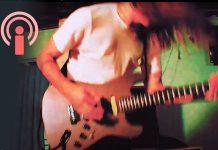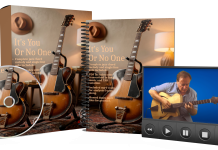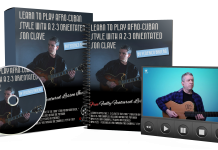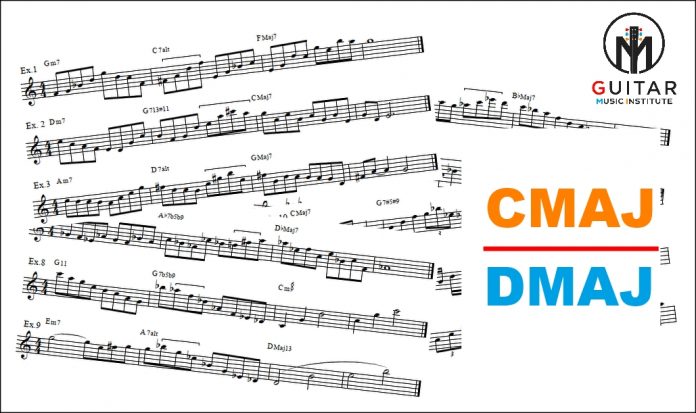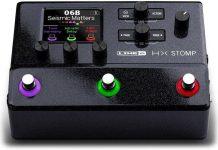This post may contain affiliate links. As an Amazon associate, Google associate as well as associate for other programs, Guitar & Music Institute may earn commissions from qualifying purchases.

WHAT ARE UPPER VOICINGS?
Context
If you have ever looked at weird named dominant chords, or come to that major or minor chords and thought, how do you play over those chords then this article is for you.
For example, look at the musical idea below and take particular notice of the second bar (measure).

You may have come across chords like this, but how exactly do you deal with them in a musical sense? More than this, how do you go about playing an arpeggio over such a chord?
Route one would be to simple take an A flat seven arpeggio and then flatten the fifth note then add in the flattened ninth note. In the following diagram, you can see one particular working out of using this method.
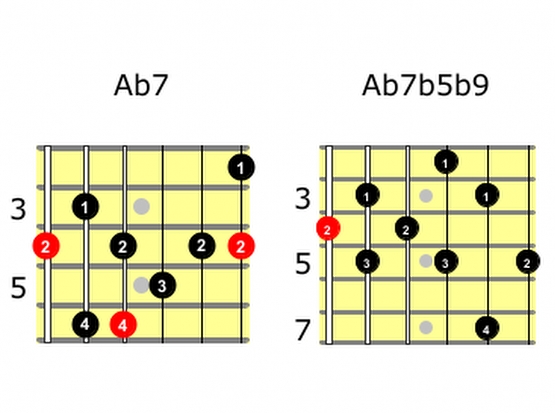
As you will probably notice, the second arpeggio is quite difficult to play and is also not that easy to remember for moving around the fretboard or finding the shape in other keys. As well as this, these odd shape will need to be learned all over the guitar neck.
So, what are the actual notes that make up A flat seven flat five/flat nine?
A flat (root) – C (third) – D (flattened fifth) – G flat (flattened seventh) – A (flattened ninth). We will come back to this example later on, but for now let’s understand what upper voicings are and how they are constructed.
INTRODUCING UPPER VOICINGS
Upper voicings, simply put, is where one chord is played on top of another. You can see three examples immediately below. You will notice that unlike “slash” voicings where there is a diagonal line between the upper chord and the lower bass note, with upper voicings, the line is horizontal. In this case “both” upper and lower entities are considered chordal.

Often, upper voicings will be referred to as “polychords”. These naming conventions are fairly loose, however, some people insist that the term upper voicings should only be used when the lower chord is stripped back to its core notes but can still function as the original chord. This technique is used to avoid duplication with notes in the upper chord.
For example, with regards dominant seventh chords, if we look at the middle example shown below, the “E7” chord would be stripped back to its tri-tone; D and G sharp notes. These two notes are all that is needed for the lower chord (E7) to function as a dominant seventh.
In this particular case, however, the player may well play the root of E7 – E and the flattened seventh “D” and miss out the G sharp in the lower chord avoiding the duplication of this note which is also found within the F minor chord but is spelt with its enharmonic equivalent “A flat”.
MAKING THE CONNECTION BETWEEN CHORD SYMBOLS
To be able to use upper voicings effectively, you do need to understand what their respective chord symbol would be. If we look at the three examples shown in the last image above the chord symbols associated with these three chords would be:
 Let’s look at each chord example in turn:
Let’s look at each chord example in turn:
Example 1. C Major over a D minor chord – the C Major notes would be heard and function as upper partials to the underlying D minor sonority. The notes in C minor would therefore function as follows – C as the flat 7th of D minor, E as the 9th of D minor and G as the 11th of D minor.
Example 2. F minor over E7 – the F minor notes function – F as the flattened ninth of E7, A flat as the 3rd of E7 and C as the sharpened 5th of E7. Note that the 5th in E7 is omitted so as not to create a clash with the sharpened fifth in the upper structure.
Example 3. D augmented over C7 – the D aug notes function – D as the 9th of C7, F sharp as the sharp eleven (or flattened fifth) of C7 and A sharp as the flattened seventh of C7. Note that the 5th in C7 is omitted so as not to create a clash with the sharpened fifth in the upper structure.
HOW DOES THIS HELP?
One of the ways that people learn guitar, especially when considering complex harmonic and melodic structures is through visualization. By using the cumulative method of learning where you take known structures such as the one shown at the top of the page, then start altering, it just makes life very difficult.
By using upper structures, we can address a very wide range of complex sounds by utilizing simple triadic voicings and arpeggios we already know.
Study the diagram below. If you look at the notes held within the red dotted lines, you’ll see that they are just simple minor arpeggios and in most cases, make up minor chords that in most cases, you’ll already know.
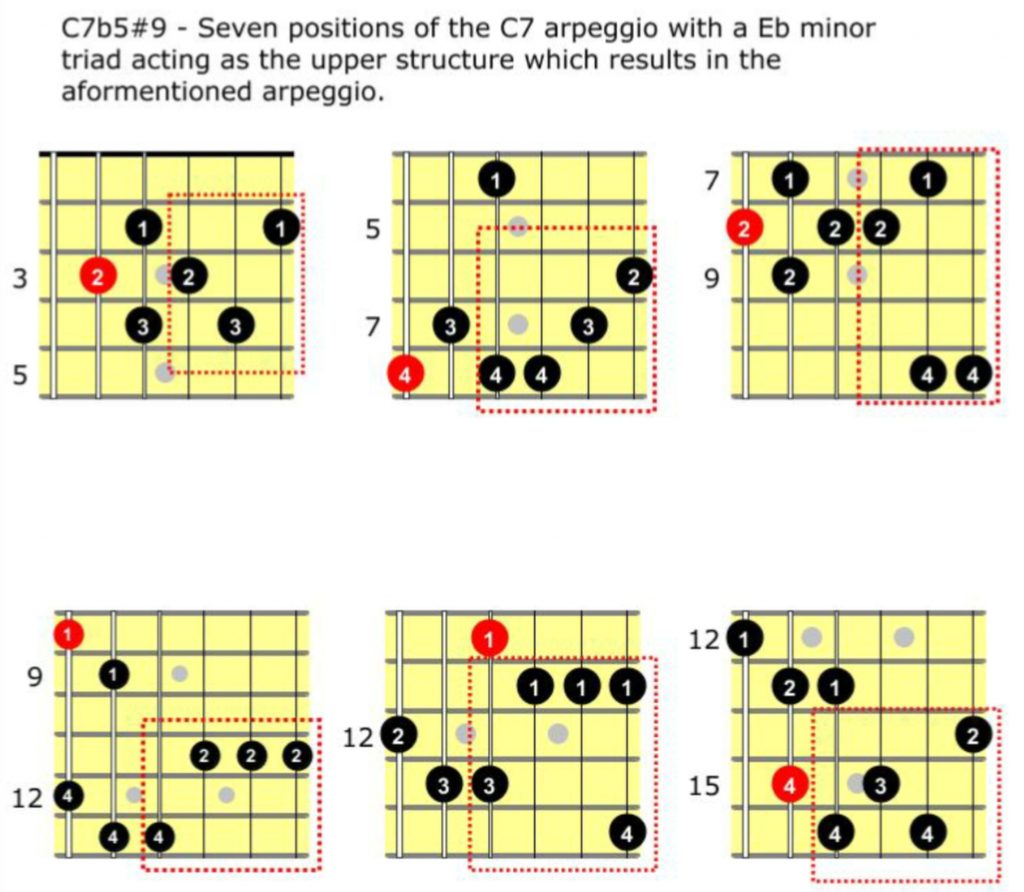
Now, look at the chord that you would be playing over – C7 flat 5/sharp 9. Now, not all of these ideas are going to be used by you as some are just plain awkward and difficult. However, you will find many of them are and keep in mind that you are combining a C7 arpeggio (no fifth) with an E flat minor arpeggio to get this complex sound.
Hopefully you get the whole point of this article which is to help you realise that less really is more when you are considering complex chords and melodic lines and that a world of melodic and harmonic expression is there for players which in most cases builds on their existing knowledge.
JUST SCRATCHING THE SURFACE
As we went into lockdown in early 2020, I started writing a book that would take fifteen months to finish. Not only was it a huge undertaking (the final page count was 362 pages), but I also played all the musical examples, solos and backing tracks that came to over a hour and a half’s worth of music.
The book went on to be called UPPER VOICINGS, SYNONYMS & SLASH VOICINGS FOR JAZZ GUITAR. Having been released in late August 2021, it has now sold across the world: USA, UK, Australia, Germany, France, Italy, Japan, Spain and Canada.
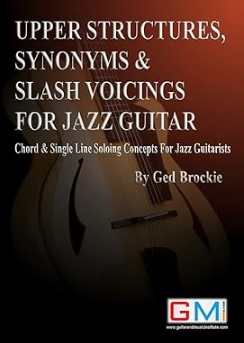
This book is also available as a spiral wire bound flat lie version which can be bought directly from the GMI Online Shop by clicking Wire Bound Upper Voicings Book.
Here is a brief content list of what is in this book.
SECTION ONE – FOUR CHAPTERS INCLUDE THE FOLLOWING TOPICS:
Stacking Chords, Chord formulae, Chord extension & alteration, Triads as upper structures, Pseudo scales, Inferring altered dominants, Generating chords across the neck, Chord & line superimposition, Voice leading, Vagrant harmony, Inferring altered dominants, Single line solo ideas, Tri-tones & flat five concepts, Chromatic movement, Deconstructing altered dominants, Synonyms, Movable solo lines, Cascading chords, Motif development, Sidestep line movement.
SECTION TWO:
A three chapter lick library of 70 original lick ideas that demonstrate each upper structure voicing category. All licks are offered in mp3 format as well as including narration from the author on the points of interest and technical challenges of the line.
Each lick is provided in musical and TAB notation. Every chord type includes arpeggio patterns across the fretboard with large format easy to view chords included with each lick example.
SECTION THREE:
Three chapters offering original jazz guitar solo examples over three well known jazz standard progressions. Full analysis from a comparative, melodic and harmonic viewpoint is included. Solos are fully notated in music and TAB with chords provided in large easy to view format.
SUPPORTING DOWNLOAD
Over one and a half hours of mp3 files included. Section 1 music examples, Section 2 demonstration licks with author’s technical narration and Section 3 which includes complete solo demonstrations as well as a wide range of backing tracks for you to practice over the three included sequences. There are one hundred and sixty nine mp3 files in total.
If you have struggled to play over complex sounding chords, or your baffled by how you can possibly learn so many chord shapes and arpeggios, I know that this book will be a key to unlocking many musical doors.
If you are ready both technically and musically to do so, Upper Structures, Synonyms and Slash Voicings For Jazz Guitar will lead you to a higher level of musical expression from both a melodic and harmonic standpoint.
DOWNLOAD PRODUCT
GMI also has a download product for upper voicings that is an introduction to the book viewed above. You can download the product by clicking Upper Voicings For Jazz Guitar or use the buy now button below.
DO YOU FIND IT DIFFICULT TO SOLO OVER CONFUSING & COMPLICATED CHORD SYMBOLS? PERHAPS YOUR LOOKING FOR NEW IDEAS TO USE IN YOUR SOLOS? IF SO, THIS PACKAGE IS FOR YOU!
THIS DOWNLOAD PRODUCT INCLUDES
17 page PDF.
26 line ideas for jazz and popular chord progressions.
Nine altered dominant chord types covered.
All examples notated in both music and TAB for easy reading and performance.
All lines offered in mp3 files at both normal and half speed for study.
PLEASE NOTE: THIS IS A MULTI FILE DOWNLOAD AND THE DIGITAL FILES (PDF, MP3 AUDIO) HAVE BEEN PACKED USING THE WINDOWS 10 COMPRESSION PROGRAM
This post may contain affiliate links. As an Amazon associate, Google associate as well as associate for other programs, Guitar & Music Institute may earn commissions from qualifying purchases.

